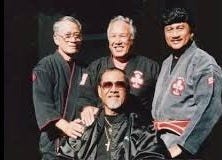If you knew all of these, print yourself up a certificate that says “I’m an honorary Mitch Powell.” This article is viable to be updated if new information is discovered.
Though the name “Kajukenbo” had been created sometime between 1947 and 1948, it wasn’t until 1957 that the art being taught was officially given the name “Kajukenbo”.
In 1946 Adriano Emperado enlisted in the U.S. Army. Around the same time he started learning Kenpo Jiu-jutsu from William Kwai-Sun Chow and James Mitose, who was Chow's instructor. (UPDATE from Mitch Powell: Emperado was drafted into the army in December of 1945, discharged in 1947, and then started training with Chow. He was probably with Chow for 4-6 months before going back to the army.) From Chow, Emperado most likely received his black belt in 1949. That’s only two years. BUT…
Before training in Kenpo Jiu-jutsu, Emperado had training in Western Boxing, Escrima, Jiu-jutsu, and Judo. His first introduction to the fighting arts was Boxing, at age 8.
Among the original 5 founders, three of them did Kenpo Jiu-jutsu, three did Danzan-Ryu Jiu-jutsu, two did Judo, one did Southern Kung Fu (before the 1960s), and three did Western Boxing. There is no evidence of any of them doing “Karate”, though there are stories that indicate street fighting had an impact in what they put together. This includes the head stomps. (UPDATE from Mitch Powell: Though many believe Chang taught Southern Kung Fu, that idea is attributed to him teaching “Hakka Kung Fu”. However, “Hakka” is a specific culture that Chang’s instructor was a part of, and what that instructor taught was a hybrid style, so it may be incorrect to say Chang studied a “Southern” style of Kung Fu. Or it may be correct. That’s another debate to get into.)
Before Brazilian Jiu-jutsu got big, there was far less ground work associated with the word “Jiu-jutsu” (though it was definitely there). Until the Japanese public started looking down on Jiu-jutsu’s violence, which led to the creation of Judo, “Jiu-jutsu” was basically unarmed combat for samurai, who relied on bows, spears, and swords anyway. This means that any old school of Jiu-jutsu you come across may also have relied on strikes and take downs as much, if not more, than the wrestling we see in modern ideas of “Jiu-jutsu”. That’s why traditional Kajukenbo (which has Danzan Ryu Jiu-jutsu roots) doesn’t have as much ground work as BJJ or Greco-Roman Wrestling.
Also, the Japanese pronunciation is “Jiu-jutsu”, but since English and Portuguese speakers had terrible pronunciation it came to be pronounced as “Jiu-jitsu” in gaikokujin English.Adriano Emperado was known to have been ordained in the Church of Jesus Christ of Latter-day Saints.
The Chinese characters you see on some Kajukenbo coat-of-arms (拳法功夫) are read "Chuán Fa Kung Fu". "Chuán Fa" is the Chinese translation for "Kenpo". When someone says they do “Chuán Fa Kajukenbo” they are actually saying they do “Kenpo Kajukenbo”.
The Kalihi Valley, where the founders are said to have gotten into fights to test their techniques, was known to be rough, partly due to being one of the poorest neighborhoods in Hawaii, as well as being the home of the state’s largest jail, the Oʻahu Community Correctional Center.
Joseph Emperado was promoted to black belt in 1952. He is credited with creating the original Pinans (Palama Sets) 4 and 7.
After Joseph Emperado’s passing, Kajukenbo pioneers like John Leoning, Tony Ramos, Aleju Reyes, Tony Lasit, and others claimed that Joseph had been their primary instructor. In 2022, Joseph Emperado was posthumously granted 10th degree rank and the official title of a “co-creator” of Kajukenbo.





I didn’t know that Sijo was Mormon. But I did notice in an interview he gave with GM John Bishop that he related the Mormon version of the fall of Lucifer.